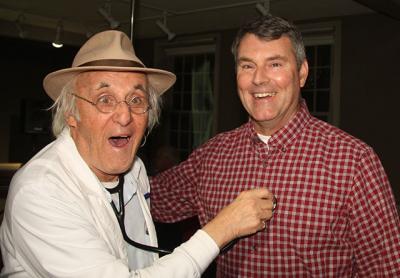The Days of House Calls and Tick Fever

At a standing-room-only talk at Clinton Academy on Friday night, the feeling was more of a family reunion than a lecture.
“Dr. David Edwards and Dr. Doris Zenger: Healing a Village,” the first in the series titled “Doctors, House Calls, and Hospitals: Keeping Well in East Hampton,” was almost full well before the 7 p.m. start time, and interested residents and visitors, young and old, kept arriving even after it began. Barbara Strong Borsack — who was delivered, along with her siblings, by Dr. Dave, as Dr. Edwards was called — introduced the usual speakers, including Hugh King, who had taught history to several audience members, and Ken Collum, who has been a presenter at the lecture series for many years and whose father had painted Dr. Zenger’s shingle. Richard Barons, the historical society’s curator, had placed Dr. Edwards’s kit, a surgeon’s roll and 45 tools, in a case near the lectern for people to see.
Dr. Zenger grew up on Abraham’s Path in Amagansett and was the first woman doctor to practice in East Hampton. Her bedside manner was described as firm but reassuring. She graduated from East Hampton High School in 1937 and had been a patient of Dr. David Edwards’s as a child. Hers was a childhood marked, from the age of 8, by osteomyelitis, a bone disease. It was likely this circumstance that piqued her interest in what made people ill and what made them better.
Before antibiotics were developed, she was given treatment with maggots raised in germ-free conditions, whose job it was to eat the diseased bone tissue. She had flare-ups for many years. Dr. Zenger graduated from the University of Michigan with the class of 1948 and did various internships. She also worked for more than two years at Rockefeller Institute for Medical Research in Manhattan. She ascribed her admission to medical school to the war and the need for more doctors, rather than to her own ability.
After moving back to East Hampton, Dr. Zenger worked briefly with Dr. Edwards before opening her own practice, which she ran while rearing two sons. Nellie Hildreth acted as her housekeeper, nurse, secretary, and second mother to Dr. Zenger’s boys.
Two of Dr. David Edwards’s grown-up grandchildren were in the audience. His family had settled in East Hampton in 1650, and their descendants are many. Dr. Dave practiced as an orthopedic surgeon and obstetrician for almost 63 years here, starting in 1901, having graduated from Bellevue Hospital Medical College in 1899. He was also appointed the town health officer and was acting assistant surgeon of the United States Public Health Service at the Port of Sag Harbor; he cared for personnel of the U.S. Life Saving Service (later the Coast Guard) from Montauk Point to East Moriches.
Dr. Dave’s long career overlapped the two world wars and, in addition to bringing thousands of Bonac babies into the world, he treated soldiers and airmen in the whole area. As the only physician between Montauk and Southampton for many years, he often rode on horseback to visit his patients. He was the first physician to recognize the existence here of “tick fever,” or Rocky Mountain spotted fever.
Ann Roberts and Russell Bennett, each a grandchild of Dr. Dave, told anecdotes about the time they had spent with him. He was exacting, it seems, but “never let his work get in the way of his life.” When she was only 13, he allowed Ms. Roberts, who lived with him for 10 years, to drive him to Southampton and, as they were leaving East Hampton Town, said, “Keep it to 55.” When a boyfriend had been banished, he told her, “There are plenty of pebbles on the beach.”
Dr. Dave owned a series of Brittany spaniels, Ms. Roberts said, each one named Doc. While eating dinner with the family, he would have the phone at hand and would answer it, asking, “How is your beloved? . . . How are your bowels?”
The next talk in the historical society’s series will be given by Hilary Osborn Malecki on Feb. 23 on the topic of the deadly influenza epidemic of 1918.
